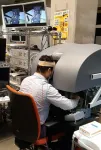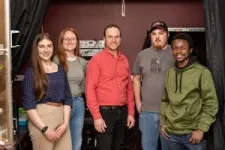(Press-News.org) People who received gentle electric currents on the back of their heads learned to maneuver a robotic surgery tool in virtual reality and then in a real setting much more easily than people who didn’t receive those nudges, a new study shows.
The findings offer the first glimpse of how stimulating a specific part of the brain called the cerebellum could help health care professionals take what they learn in virtual reality to real operating rooms, a much-needed transition in a field that increasingly relies on digital simulation training, said author and Johns Hopkins University roboticist Jeremy D. Brown.
“Training in virtual reality is not the same as training in a real setting, and we’ve shown with previous research that it can be difficult to transfer a skill learned in a simulation into the real world,” said Brown, the John C. Malone Associate Professor of Mechanical Engineering. “It's very hard to claim statistical exactness, but we concluded people in the study were able to transfer skills from virtual reality to the real world much more easily when they had this stimulation.”
The work appears today in Nature Scientific Reports.
Participants drove a surgical needle through three small holes, first in a virtual simulation and then in a real scenario using the da Vinci Research Kit, an open-source research robot. The exercises mimicked moves needed during surgical procedures on organs in the belly, the researchers said.
Participants received a subtle flow of electricity through electrodes or small pads placed on their scalps meant to stimulate their brain’s cerebellum. While half the group received steady flows of electricity during the entire test, the rest of the participants received a brief stimulation only at the beginning and nothing at all for the rest of the tests.
People who received the steady currents showed a notable boost in dexterity. None of them had prior training in surgery or robotics.
“The group that didn’t receive stimulation struggled a bit more to apply the skills they learned in virtual reality to the actual robot, especially the most complex moves involving quick motions,” said Guido Caccianiga, a former Johns Hopkins roboticist, now at Max Planck Institute for Intelligent Systems, who designed and led the experiments. “The groups that received brain stimulation were better at those tasks.”
Noninvasive brain stimulation is a way to influence certain parts of the brain from outside the body, and scientists have shown how it can benefit motor learning in rehabilitation therapy, the researchers said. With their work, the team is taking the research to a new level by testing how stimulating the brain can help surgeons gain skills they might need in real-world situations, said co-author Gabriela Cantarero, a former assistant professor of physical medicine and rehabilitation at Johns Hopkins.
“It was really cool that we were actually able to influence behavior using this setup, where we could really quantify every little aspect of people’s movements, deviations, and errors,” Cantarero said.
Robotic surgery systems provide significant benefits for clinicians by enhancing human skill. They can help surgeons minimize hand tremors and perform fine and precise tasks with enhanced vision.
Besides influencing how surgeons of the future might learn new skills, this type of brain stimulation also offers promise for skill acquisition in other industries that rely on virtual reality training, particularly work in robotics.
Even outside of virtual reality, the stimulation can also likely help people learn more generally, the researchers said.
“What if we could show that with brain stimulation you can learn new skills in half the time?” Caccianiga said. “That’s a huge margin on the costs because you’d be training people faster; you could save a lot of resources to train more surgeons or engineers who will deal with these technologies frequently in the future.”
Other authors include Ronan A. Mooney of the Johns Hopkins University School of Medicine, and Pablo A. Celnik of the Shirley Ryan AbilityLab.
END
Could an electric nudge to the head help your doctor operate a surgical robot?
2023-12-20
ELSE PRESS RELEASES FROM THIS DATE:
Mount Sinai researchers develop novel method to improve disease prediction across diverse ancestries
2023-12-20
A team of scientists from Icahn School of Medicine at Mount Sinai has developed a groundbreaking statistical technique, “BridgePRS,” to enhance disease prediction in people of non-European ancestry, particularly those of African descent. This development represents a substantial step towards reducing health care inequities and a future of more personalized and precise medical interventions based on genetic information. Details of their work were published in Nature Genetics on Wednesday, December 20.
Current polygenic risk scores (PRS), essential tools for predicting disease risk encoded in our ...
How researchers are “CReATiNG” synthetic chromosomes faster and cheaper
2023-12-20
A groundbreaking new technique invented by researchers at the USC Dornsife College of Letters, Arts and Science may revolutionize the field of synthetic biology. Known as CReATiNG (Cloning Reprogramming and Assembling Tiled Natural Genomic DNA), the method offers a simpler and more cost-effective approach to constructing synthetic chromosomes. It could significantly advance genetic engineering and enable a wide range of advances in medicine, biotechnology, biofuel production and even space exploration.
CReATiNG works by cloning and reassembling natural DNA segments from yeast, allowing scientists to create synthetic chromosomes that can replace their native counterparts in cells. ...
IOP Publishing expands open access in Asia Pacific region with its first Read and Publish agreement in Taiwan
2023-12-20
IOP Publishing (IOPP) has secured its first ‘Read and Publish’ transformative agreement in Taiwan, demonstrating its dedication to expanding open access (OA) to research in the Asia-Pacific (APAC) region and at scale globally.
The three-year transformative agreement with the Physics Research Promotion Centre, which is part of the National Science and Technology Council (NSTC), will enable 20 Taiwanese universities to offer their researchers unlimited OA publishing at no cost to them. The agreement will also allow authors to retain copyright ...
Mediterranean diet ‘a straightforward approach’ among many nutritional options for improving the chance of success in IVF
2023-12-20
Adjuvant therapies to help infertile women conceive by IVF - especially those whose treatments have been unsuccessful in the past - are now a common feature both before and during the treatment cycle. Now, a new analysis of the evidence for many nutritional supplements and diets thought to improve outcome in IVF has concluded that adopting a Mediterranean diet during treatment would offer a single ‘straightforward approach’ with good evidence of benefit in contrast to that of a Western diet.
Evidence from studies of nine commonly used nutritional supplements was found to be inconsistent and not always of good quality. The analysis, by Professor Roger ...
Could gamma brain stimulation help combat Alzheimer’s disease?
2023-12-20
A review in the Journal of Internal Medicine explores the potential of non-invasive interventions such as light, sound, and magnets to stimulate gamma brain waves for the treatment of Alzheimer’s disease. Such strategies may be beneficial because Alzheimer’s disease is characterized by reduced fast brain oscillations in the gamma range (30–100 Hz).
The authors note that recent studies reveal that it is feasible and safe to induce 40 Hz brain activity in patients with Alzheimer’s disease through a range of methods. Also, preliminary evidence suggests that such treatment can yield beneficial ...
How does the inability to burp affect daily life?
2023-12-20
The inability to burp—called retrograde cricopharyngeus dysfunction (R-CPD)—is caused by failure of the throat’s cricopharyngeal muscle to relax to allow the outward passage of gas. An interview-based study in Neurogastroenterology & Motility that included 199 adults affected by the condition reveals the impact of R-CPD on quality of life.
Most participants reported abdominal bloating, socially awkward gurgling noises, excessive flatulence, and difficulty vomiting. Only half discussed their symptoms with their primary care clinician, and 90% felt they did not receive ...
Does losing a parent during childhood contribute to separation anxiety and anxious attachment in women?
2023-12-20
Women who lost a parent early in life may be more likely to experience separation anxiety with romantic partners during adulthood, according to a study published in Stress and Health. In addition to feeling distressed when separated from their partners, these women may also experience anxious attachment, or worry that significant others will not be available at times of need.
The study included 60 women who lost one or both parents in their youth and 60 who had living parents. Based on participants’ answers to questionnaires, women who lost a parent reported higher levels of anxious attachment and adult separation anxiety ...
Do steroid creams affect bone health?
2023-12-20
New research indicates that higher doses of topical corticosteroids, which are commonly used to treat inflammatory skin conditions, are linked with elevated risks of osteoporosis and bone fractures associated with osteoporosis. The findings are published in the Journal of the European Academy of Dermatology and Venereology and are based on information from the Taiwan National Health Insurance Research Database.
Investigators selected 129,682 osteoporosis cases and 34,999 major osteoporotic fracture (MOF) cases and matched them with 518,728 and 139,996 controls (without osteoporosis or MOF) ...
360-degree head-up display view could warn drivers of road obstacles in real time
2023-12-20
Researchers have developed an augmented reality head-up display that could improve road safety by displaying potential hazards as high-resolution three-dimensional holograms directly in a driver’s field of vision in real time.
Current head-up display systems are limited to two-dimensional projections onto the windscreen of a vehicle, but researchers from the Universities of Cambridge, Oxford and University College London (UCL) developed a system using 3D laser scanner and LiDAR data to create a fully 3D representation of London streets.
The system ...
Taking out the cellular trash
2023-12-20
If we don’t take out the trash regularly, our homes become unpleasant and even a danger to our health. The same applies to our cells: If excess proteins and strands of genetic material aren’t removed, the cell and ultimately the entire organism can fall ill. For instance, scientists suspect there is a connection between Alzheimer’s and mutations that cause defects in cellular garbage removal. What’s more, tests with mice have shown that suppressing the breakdown of DNA and RNA can trigger serious autoimmune diseases.
But concrete evidence is missing: “There’s a lot of research showing how genetic information in the ...







